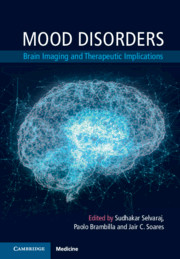Book contents
- Mood Disorders
- Mood Disorders
- Copyright page
- Contents
- Contributors
- Preface
- Section 1 General
- Section 2 Anatomical Studies
- Section 3 Functional and Neurochemical Brain Studies
- Chapter 5 Brain Imaging of Reward Dysfunction in Unipolar and Bipolar Disorders
- Chapter 6 Resting-State Functional Connectivity in Unipolar Depression
- Chapter 7 Functional Connectome in Bipolar Disorder
- Chapter 8 Magnetic Resonance Spectroscopy Investigations of Bioenergy and Mitochondrial Function in Mood Disorders
- Chapter 9 Imaging Glutamatergic and GABAergic Abnormalities in Mood Disorders
- Chapter 10 Neuroimaging Brain Inflammation in Mood Disorders
- Section 4 Novel Approaches in Brain Imaging
- Section 5 Therapeutic Applications of Neuroimaging in Mood Disorders
- Index
- Plate Section (PDF Only)
- References
Chapter 6 - Resting-State Functional Connectivity in Unipolar Depression
from Section 3 - Functional and Neurochemical Brain Studies
Published online by Cambridge University Press: 12 January 2021
- Mood Disorders
- Mood Disorders
- Copyright page
- Contents
- Contributors
- Preface
- Section 1 General
- Section 2 Anatomical Studies
- Section 3 Functional and Neurochemical Brain Studies
- Chapter 5 Brain Imaging of Reward Dysfunction in Unipolar and Bipolar Disorders
- Chapter 6 Resting-State Functional Connectivity in Unipolar Depression
- Chapter 7 Functional Connectome in Bipolar Disorder
- Chapter 8 Magnetic Resonance Spectroscopy Investigations of Bioenergy and Mitochondrial Function in Mood Disorders
- Chapter 9 Imaging Glutamatergic and GABAergic Abnormalities in Mood Disorders
- Chapter 10 Neuroimaging Brain Inflammation in Mood Disorders
- Section 4 Novel Approaches in Brain Imaging
- Section 5 Therapeutic Applications of Neuroimaging in Mood Disorders
- Index
- Plate Section (PDF Only)
- References
Summary
Unipolar depression, also known as unipolar or major depressive disorder (MDD), is a globally prevalent psychiatric disorder characterized by persistent sadness and a loss of interest in normally enjoyable activities, accompanied by an inability to carry out daily activities, for at least two weeks. Furthermore, patients with unipolar depression usually exhibit some of the following symptoms: loss of energy, sleeping more or less, anxiety, change in appetite, reduced concentration, indecisiveness, feeling of worthlessness, guilt, hopelessness, and thoughts or acts of self-harm or suicide. The lifetime risk of depression is approximately 10–20%, with rates being almost doubled in women.
- Type
- Chapter
- Information
- Mood DisordersBrain Imaging and Therapeutic Implications, pp. 49 - 58Publisher: Cambridge University PressPrint publication year: 2021

